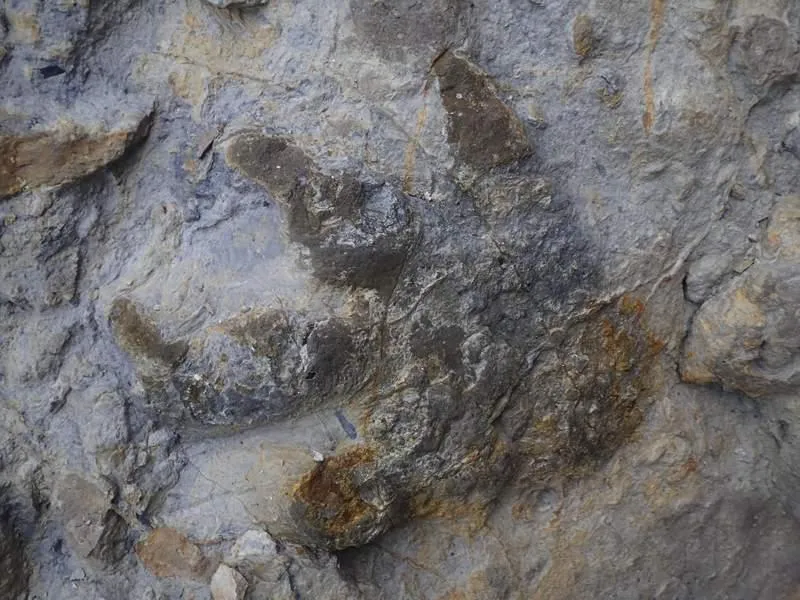Trove of Well-Preserved Dinosaur Footprints Unearthed Along Sussex Coast
Researchers discovered more than 85 fossilized footprints left by at least seven prehistoric species
/https://tf-cmsv2-smithsonianmag-media.s3.amazonaws.com/filer/6c/53/6c536517-8ac9-4cba-b44a-ade7134d12bf/iguanodon.jpg)
Some 100 to 145 million years ago, dinosaurs including the plant-eating Iguanodon, long-necked Diplodocus and club-tailed Ankylosaurus roamed the coast of what is now East Sussex, England, scattering imprints of their unique gaits across the region’s terrain. But over the millennia that followed, these footprints were obscured by the build-up of sandstone and mudstone cliffs—a phenomenon that simultaneously masked the impressive array of preserved prints and ensured their survival to this day.
Now, Rhys Blakely writes for The Times, researchers from the University of Cambridge say they’ve discovered more than 85 fossilized footprints left by at least seven of these prehistoric dinosaur species. The imprints, which were unearthed by winter storm-driven coastal erosion over the past four years, range in size from less than 2 centimeters to around 60 centimeters, or two feet, across. They are so well-preserved that details such as skin, scales and claws can be readily seen.
The scientists’ find, newly detailed in the journal Palaeogeography, Palaeoclimatology, Palaeoecology, reportedly represents the most detailed and diverse collection of Cretaceous fossils ever discovered in Great Britain. (The Cretaceous Period began with the close of the Jurassic Period about 145.5 million years ago and ended with a mass extinction event some 65 million years ago.)
Although the area surrounding Hastings, a coastal town in East Sussex, has long been touted as a promising dig site for fossil hunters—Josh Gabbatiss of The Independent notes that the first known Iguanodon was discovered there in 1825, with the first confirmed example of fossilized dinosaur brain tissue following in 2016—the footprints are the first of their kind to be unearthed in 25 years. According to BBC News, earlier finds were far less varied and detailed; oftentimes, such discoveries consisted of dinosaur bone fragments rather than whole footprints.

Lead author Anthony Shillito, a PhD student in Cambridge’s Department of Earth Sciences, tells Sarah Collins of Cambridge that whole body dinosaur fossils are “incredibly rare.”
As he explains, “Usually you only get small pieces, which don’t tell you a lot about how that dinosaur may have lived. A collection of footprints like this helps you fill in some of the gaps and infer things about which dinosaurs were living in the same place at the same time.”
The Times’ Blakely reports that some of the Iguanodon prints found occur in groups, suggesting the sizable herbivores traveled in herds. Other more isolated marks point toward creatures that adopted solitary lifestyles—for example, the Ankylosaurus, a large armored dinosaur with a distinctive club-shaped tail.
The species represented by the fossils range in size from relatively tiny carnivorous theropods, which left footprints measuring about 10 inches long and stood just taller than an average human, to members of the enormous sauropod family, which includes the up to 15-ton, 72-foot-long Brontosaurus.
In an interview with Cambridge’s Collins, study co-author Neil Davies notes that the prints were likely left near a Cretaceous Period water source, as preservation requires a specific kind of environment: “The ground needs to be ‘sticky’ enough so that the footprint leaves a mark,” Davies says, “but not so wet that it gets washed away. You need that balance in order to capture and preserve them.”
Davies and Shillito hope to unearth more footprints this winter, but as Shillito tells CBC Radio’s Carol Off, developers recently finished building cedar fencing around the area, lowering the chances of storm-triggered coastal erosion.
“[It] obviously is a good thing to protect the homes of the people that are living near the cliff tops,” Shillito concludes, “but from a selfish, scientific point, the downside is that we might not see any new prints coming out of the cliffs for awhile.”
/https://tf-cmsv2-smithsonianmag-media.s3.amazonaws.com/accounts/headshot/mellon.png)
/https://tf-cmsv2-smithsonianmag-media.s3.amazonaws.com/accounts/headshot/mellon.png)